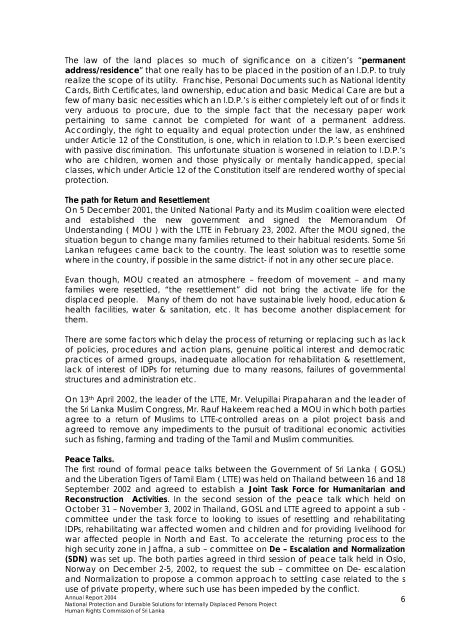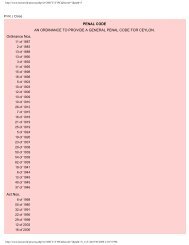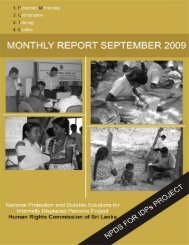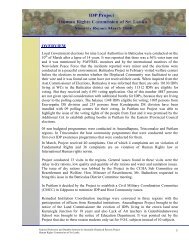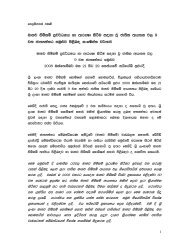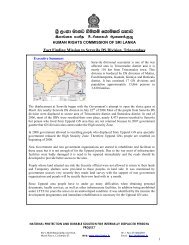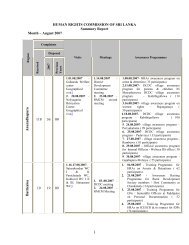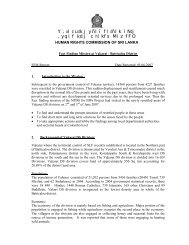2004 Annual Report, NPDS Project.pdf - IDP SriLanka
2004 Annual Report, NPDS Project.pdf - IDP SriLanka
2004 Annual Report, NPDS Project.pdf - IDP SriLanka
- No tags were found...
You also want an ePaper? Increase the reach of your titles
YUMPU automatically turns print PDFs into web optimized ePapers that Google loves.
The law of the land places so much of significance on a citizen’s “permanentaddress/residence” that one really has to be placed in the position of an I.D.P. to trulyrealize the scope of its utility. Franchise, Personal Documents such as National IdentityCards, Birth Certificates, land ownership, education and basic Medical Care are but afew of many basic necessities which an I.D.P.’s is either completely left out of or finds itvery arduous to procure, due to the simple fact that the necessary paper workpertaining to same cannot be completed for want of a permanent address.Accordingly, the right to equality and equal protection under the law, as enshrinedunder Article 12 of the Constitution, is one, which in relation to I.D.P.’s been exercisedwith passive discrimination. This unfortunate situation is worsened in relation to I.D.P.’swho are children, women and those physically or mentally handicapped, specialclasses, which under Article 12 of the Constitution itself are rendered worthy of specialprotection.The path for Return and ResettlementOn 5 December 2001, the United National Party and its Muslim coalition were electedand established the new government and signed the Memorandum OfUnderstanding ( MOU ) with the LTTE in February 23, 2002. After the MOU signed, thesituation begun to change many families returned to their habitual residents. Some <strong>SriLanka</strong>n refugees came back to the country. The least solution was to resettle somewhere in the country, if possible in the same district- if not in any other secure place.Evan though, MOU created an atmosphere – freedom of movement – and manyfamilies were resettled, “the resettlement” did not bring the activate life for thedisplaced people. Many of them do not have sustainable lively hood, education &health facilities, water & sanitation, etc. It has become another displacement forthem.There are some factors which delay the process of returning or replacing such as lackof policies, procedures and action plans, genuine political interest and democraticpractices of armed groups, inadequate allocation for rehabilitation & resettlement,lack of interest of <strong>IDP</strong>s for returning due to many reasons, failures of governmentalstructures and administration etc.On 13 th April 2002, the leader of the LTTE, Mr. Velupillai Pirapaharan and the leader ofthe Sri Lanka Muslim Congress, Mr. Rauf Hakeem reached a MOU in which both partiesagree to a return of Muslims to LTTE-controlled areas on a pilot project basis andagreed to remove any impediments to the pursuit of traditional economic activitiessuch as fishing, farming and trading of the Tamil and Muslim communities.Peace Talks.The first round of formal peace talks between the Government of Sri Lanka ( GOSL)and the Liberation Tigers of Tamil Elam ( LTTE) was held on Thailand between 16 and 18September 2002 and agreed to establish a Joint Task Force for Humanitarian andReconstruction Activities. In the second session of the peace talk which held onOctober 31 – November 3, 2002 in Thailand, GOSL and LTTE agreed to appoint a sub -committee under the task force to looking to issues of resettling and rehabilitating<strong>IDP</strong>s, rehabilitating war affected women and children and for providing livelihood forwar affected people in North and East. To accelerate the returning process to thehigh security zone in Jaffna, a sub – committee on De – Escalation and Normalization(SDN) was set up. The both parties agreed in third session of peace talk held in Oslo,Norway on December 2-5, 2002, to request the sub – committee on De- escalationand Normalization to propose a common approach to settling case related to the suse of private property, where such use has been impeded by the conflict.<strong>Annual</strong> <strong>Report</strong> <strong>2004</strong>National Protection and Durable Solutions for Internally Displaced Persons <strong>Project</strong>Human Rights Commission of Sri Lanka6


